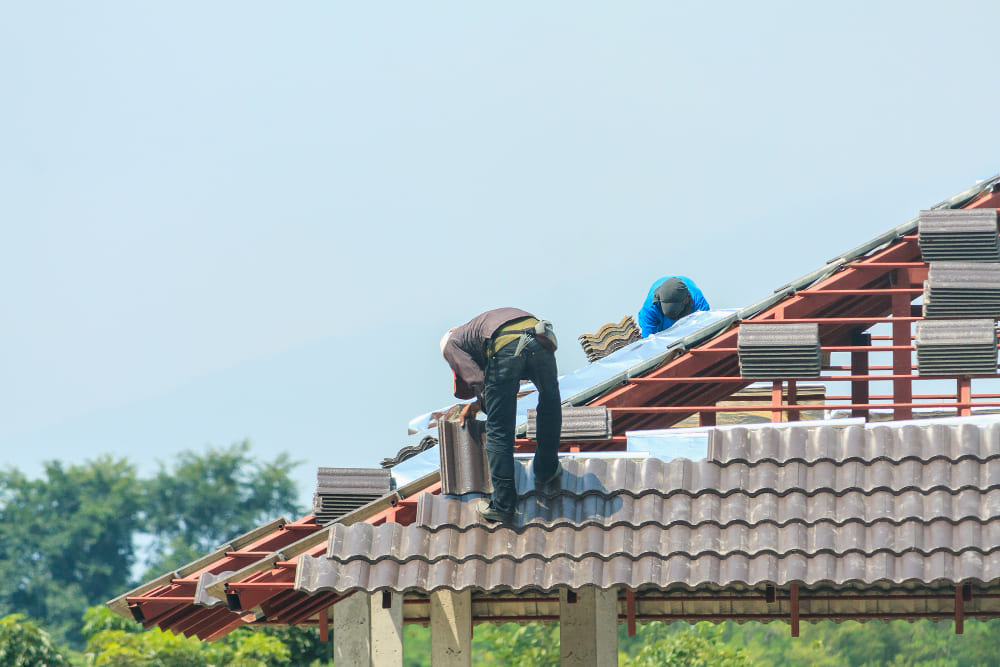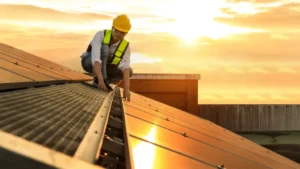One of the most essential parts of your home is the roof. A high-quality roof protects your home from the elements and adds energy efficiency and structural security to your property. That said, roofs can develop several roof problems over the years. Extreme weather, age, or maintenance negligence can lead to roof issues that often result in costly repairs and, at times, a total replacement.
Because this affects how effective your roof will be and how long it will last, know the necessary steps to take when roof problems occur in your home. This blog post will discuss some of the most conventional roof repairs, roof issue solutions or methods to do the same, and how to avoid roof problems. We’ll go more in-depth into roof shingles, wind damage, roof leaks, hail damage, and so on! This guide will show you how to recognize, remedy, and avoid the most common roof issues.
What Are the Most Common Roof Repairs?
The following are the most common roofing issues that a homeowner will face in or before the life of a roof. Roofing problems can range from mild to severe, but identifying them early will prevent you from spending large amounts on repairs. Here are the roofer’s most common types of roof repairs requested by homeowners, along with their symptoms, causes, and remedies.
1. Roof Leaks — The Problem That Might Go Unnoticed
The most common roof issue is roof leaks. There are many causes of leaks, including missing shingles, cracked flashing, clogged gutters, roof membrane damage, and more. Leakage could be just a minor issue at first, but it will lead to extensive water damage if the problem is not addressed.
Signs of Roof Leaks:
- Ceiling or wall Water Stains
- Mold or mildew growth in the attic spaces and along the walls
- Holes or cracks in the roofing material that can be visually seen
Solution:
However, if you see any signs of roof leaking, take immediate action before it causes extensive damage. Roofing sealants or roofing tar can be used to patch small leaks. However, if it is a larger leak, you should call a professional roofer for an inspection and repair.
2. Wind Damage to Roof Shingles: A Serious Concern
High winds can cause some of the most frequent roof issues, especially for those who experience harsh storms. Unlike hail, which damages shingles with individual dents, wind comes in the form of a series of gusts that can cause shingles to fly off, break, or otherwise lift from their adhesive strips, plaguing your roof with deficiencies in their protective gear against the rain.
Signs of Wind Damage:
- Shingles that have blown away or have been blown up during a storm
- Cracked or torn shingles.
- Another consequence of not fixing a leaky roof is the loss of granules on asphalt shingles, which shortens the roof’s life!
Solution:
Inspect your roof after any windy storm. Directly replace the missing shingles to prevent the risk of possible water leaks. For damage involving several missing shingles, it is advisable to take professional assistance from a roofer for an entire roof inspection.
To learn more about wind-damaged roof shingles, please visit our subpage [Wind Damage to Roof Shingles].
3. Hail Damage: Assessing the Impact
Roofers warn that hailstorms can destroy your roof, especially if the hailstones are large and hit very hard. The impact of hail damage creates openings in your roof, such as splits, holes, drains, and any other roofing problem, making your roof susceptible to leaks and further deterioration.
Signs of Hail Damage:
- Denting of metal or shingle roofs.
- Holes, cracks, or fractures even (of shingle, often asphalt)
- Granule loss due to shingles, making them ineffective
Solution:
Roof inspection after hail: If you live in a hail-prone area, inspecting your roof after a storm is vital. If the hail damage only covers a small area of the roof, replacing a few shingles is possible, but more extensive hail damage may necessitate replacing the entire roof. Always Consult a Professional to Assess Hail Damage
To read a breakdown of hail damage roofs, visit our subpage, Hail Damage Roof
4. How To: Ice Dams and Broken Gutters | Roofing Issues Solutions
Ice dams can form on your roof in the winter and, if left untreated, can lead to severe damage. They form when heat from your home melts snow on the roof, and the water then freezes again at the edge of the roof, creating a dam that traps water behind the shingles. Advantages of Leak Detection—This trapped water can get into your home and lead to leaks.
How Ice Dams Form:
- The warm air from your attic is melting the snow off your roof.
- The literally melted snow runs down and refreezes at the roof’s edge.
- Ice dams’ ice falls from them to form a coarse, bumpy surface of the ice structure, so water cannot rain off the roof as usual; instead, it builds atop it.
Solution:
Proper insulation in the attic prevents heat from escaping onto the roof, which helps to prevent ice dams. Also, take the time to regularly clean your gutters to rid them of debris that can inhibit water flow. If ice dams have already formed, you can safely remove them by raking snow at the roof’s edge or getting professional help.
5. Punctures or Holes in the Roof: Immediate Action Required
Holes and punctures in your roof, sometimes caused by falling debris and sometimes by a bad roof installation, are also common roof issues. Moisture can easily get through even the most minor holes, resulting in extensive damage.
Signs of Holes or Punctures:
- Holes that are seen in the roofing materials
- Damp spots or stains found in attics or on ceilings
- Water leaks or penetrating rain or snow
Solution:
If the hole is small, you can cover it using a patch or roofing sealant. When the puncture is large, only a professional can repair the damage and ensure that no more water penetrates the punctured cover.
6. Missing or Damaged Shingles: A Clear Indicator of Roof Problems
Shingles may be damaged by exposure to elements over time. One of the most common roof issues homeowners will encounter during their lives is missing shingles, damaged shingles, or cracked shingles, all of which need to be toned to be replaced quickly to avoid damage to the lower layers of the house.
Roof Worn/Missing Shingles Signs:
- Shingles are blown off after a storm/strong winds.
- Cracked or curled shingles.
- When you notice tiny bits of shingle in the gutter
Solution:
Damaged or missing shingles should be replaced right away. If the damage is extensive, you may have to replace many roof portions. A skilled, experienced roofing technician can evaluate the damage and determine the best option.
7. Roof Flashing Problems: Sealing the Edges
Flashing in roofs is used to close the lines and angles around things like chimneys, vents , and skylights. However, the flashing can deteriorate or break down and become ineffective over time, causing leaks.
Signs of Flashing Problems:
- Cracked or rusted flashing.
Improving Your Roof Damage Insurance Claim Experience:
Especially in the case of weather-related damage, you may be covered under your insurance if your roof has been damaged. How To File A Roof Damage Insurance Claim Communicate With The Insurance Adjuster Communicate With The Roofing Contractor Inspect For Damage By The End Conclusion The post First Steps In Roof Damage Insurance Claim appeared first on Econo Roofs.
Insurance Claim Process: The Steps Involved
Document the Damage: Take clear photos of the damage to your roof and its surroundings.
Call Your Insurance Company: Notify your insurer of the damage at your earliest convenience.
Send Adjuster: The insurance company usually sends an adjuster to inspect the roof and determine the loss.
Get Repair Estimates: Contact trusted roofing contractors and get repair estimates.
Partner with your insurer: Coordinate with your insurer so that you can process what it will take to restore what was lost.
Please visit our subpage on the roof damage insurance claim process to learn about It.
Malarkey Shingles Reviews – A Brand You Can Trust For Your Roof
When selecting the best roofing materials, carefully choose weather-resistant and reliable materials that can protect the house from roofing problems. Many homeowners love Malarkey shingles for their energy efficiency, durability, and longevity.
Shingle Features of Malarkey
- Wind Resistance: Malarkey shingles are designed to resist high winds, making them great for storm-prone parts of the country.
- Heating and Cooling Cost Reduction: These shingles help create a more insulated roof, lowering your heating and cooling costs as well.
- Resilience: Malarkey shingles are designed to be strong and long-lasting, protecting against weather-related damage.
Customer Reviews:
Other homeowners generally praise Malarkey shingles, particularly for their durability and reliability in makeshift climates. These shingles also defend against wind and hail damage on your roof.
Read Our Full Review on Malarkey Shingles: [Malarkey Shingles Reviews]
Conclusion: Taking Care of Your Roof
One of the biggest things keeping your home safe is your roof. Knowing when there are issues with your roof and dealing with those issues in time is essential to maintaining it so it lasts as long as possible and keeps your home safe from whatever the world throws at it. From wind damage to roof leaks, hail damage, and even ice dams, spotting the problem early will prevent substantial damage and expensive repairs.
If you have serious roof problems or need urgent repair, do not hesitate to call a qualified roof-covering contractor. Once you have had a professional roofer care for your roof, apply the proper maintenance techniques to avoid common roofing issues from reappearing later on: use top-grade materials (think Malarkey shingles)
Read our [Pillar Page What Are the Most Common Roof Repairs] and subpages to learn more about expert roofing recommendations, tricks, and services.



